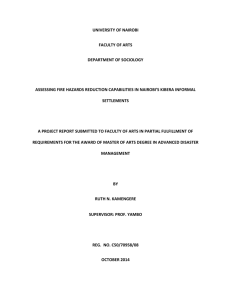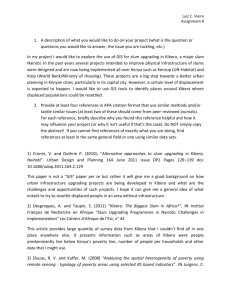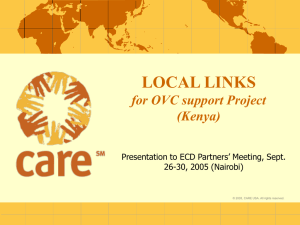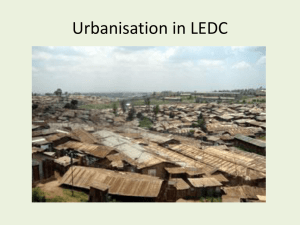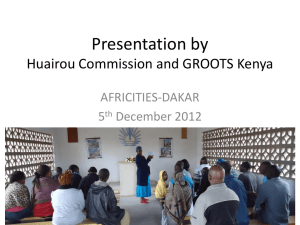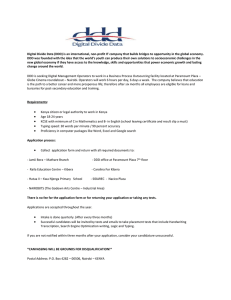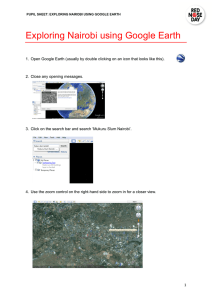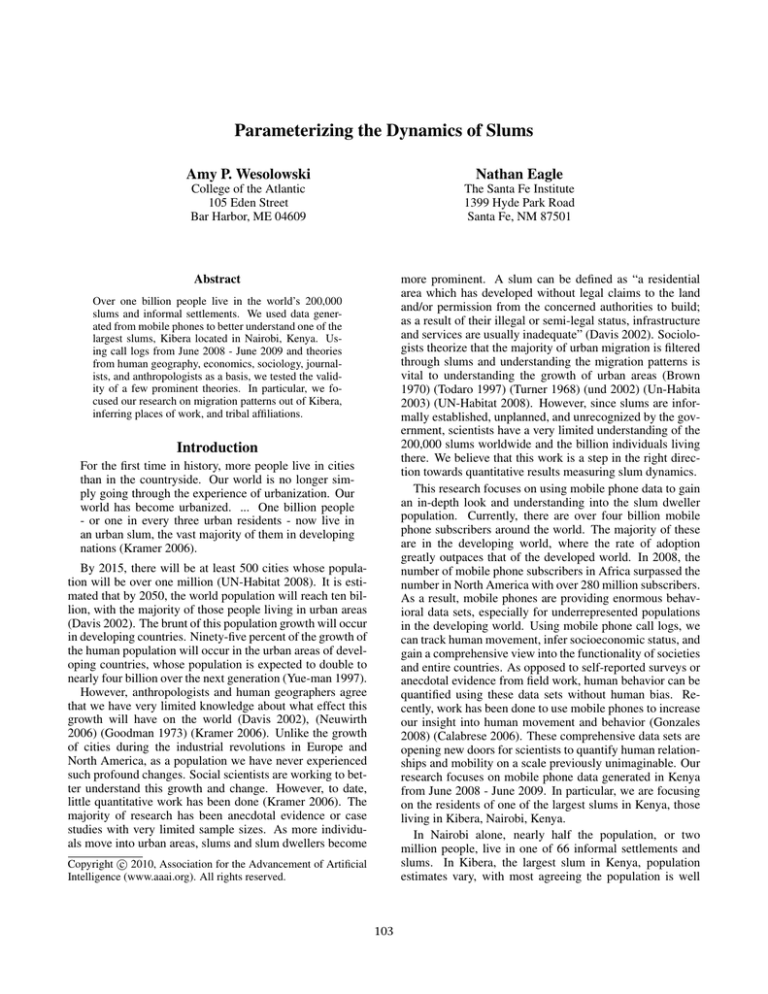
Parameterizing the Dynamics of Slums
Amy P. Wesolowski
Nathan Eagle
College of the Atlantic
105 Eden Street
Bar Harbor, ME 04609
The Santa Fe Institute
1399 Hyde Park Road
Santa Fe, NM 87501
more prominent. A slum can be defined as “a residential
area which has developed without legal claims to the land
and/or permission from the concerned authorities to build;
as a result of their illegal or semi-legal status, infrastructure
and services are usually inadequate” (Davis 2002). Sociologists theorize that the majority of urban migration is filtered
through slums and understanding the migration patterns is
vital to understanding the growth of urban areas (Brown
1970) (Todaro 1997) (Turner 1968) (und 2002) (Un-Habita
2003) (UN-Habitat 2008). However, since slums are informally established, unplanned, and unrecognized by the government, scientists have a very limited understanding of the
200,000 slums worldwide and the billion individuals living
there. We believe that this work is a step in the right direction towards quantitative results measuring slum dynamics.
This research focuses on using mobile phone data to gain
an in-depth look and understanding into the slum dweller
population. Currently, there are over four billion mobile
phone subscribers around the world. The majority of these
are in the developing world, where the rate of adoption
greatly outpaces that of the developed world. In 2008, the
number of mobile phone subscribers in Africa surpassed the
number in North America with over 280 million subscribers.
As a result, mobile phones are providing enormous behavioral data sets, especially for underrepresented populations
in the developing world. Using mobile phone call logs, we
can track human movement, infer socioeconomic status, and
gain a comprehensive view into the functionality of societies
and entire countries. As opposed to self-reported surveys or
anecdotal evidence from field work, human behavior can be
quantified using these data sets without human bias. Recently, work has been done to use mobile phones to increase
our insight into human movement and behavior (Gonzales
2008) (Calabrese 2006). These comprehensive data sets are
opening new doors for scientists to quantify human relationships and mobility on a scale previously unimaginable. Our
research focuses on mobile phone data generated in Kenya
from June 2008 - June 2009. In particular, we are focusing
on the residents of one of the largest slums in Kenya, those
living in Kibera, Nairobi, Kenya.
In Nairobi alone, nearly half the population, or two
million people, live in one of 66 informal settlements and
slums. In Kibera, the largest slum in Kenya, population
estimates vary, with most agreeing the population is well
Abstract
Over one billion people live in the world’s 200,000
slums and informal settlements. We used data generated from mobile phones to better understand one of the
largest slums, Kibera located in Nairobi, Kenya. Using call logs from June 2008 - June 2009 and theories
from human geography, economics, sociology, journalists, and anthropologists as a basis, we tested the validity of a few prominent theories. In particular, we focused our research on migration patterns out of Kibera,
inferring places of work, and tribal affiliations.
Introduction
For the first time in history, more people live in cities
than in the countryside. Our world is no longer simply going through the experience of urbanization. Our
world has become urbanized. ... One billion people
- or one in every three urban residents - now live in
an urban slum, the vast majority of them in developing
nations (Kramer 2006).
By 2015, there will be at least 500 cities whose population will be over one million (UN-Habitat 2008). It is estimated that by 2050, the world population will reach ten billion, with the majority of those people living in urban areas
(Davis 2002). The brunt of this population growth will occur
in developing countries. Ninety-five percent of the growth of
the human population will occur in the urban areas of developing countries, whose population is expected to double to
nearly four billion over the next generation (Yue-man 1997).
However, anthropologists and human geographers agree
that we have very limited knowledge about what effect this
growth will have on the world (Davis 2002), (Neuwirth
2006) (Goodman 1973) (Kramer 2006). Unlike the growth
of cities during the industrial revolutions in Europe and
North America, as a population we have never experienced
such profound changes. Social scientists are working to better understand this growth and change. However, to date,
little quantitative work has been done (Kramer 2006). The
majority of research has been anecdotal evidence or case
studies with very limited sample sizes. As more individuals move into urban areas, slums and slum dwellers become
c 2010, Association for the Advancement of Artificial
Copyright Intelligence (www.aaai.org). All rights reserved.
103
over 600,000 or around one-fifth of Nairobi’s population
(Kramer 2006). These residents live in only 5 percent of
the total residential area without basic necessities, such as
sanitation, water, healthcare, or education. However, even
with these conditions, the population of Kibera grows at
an annual rate of 12 percent (International 2009). From
the characteristics of slums and typical slum residents,
overarching trends and patterns of migration are extremely
difficult to quantify.
Nonetheless, through aggregate
statistics we have found a number of trends that can further
classify and understand slum movement in Kibera. This paper represents the exploratory phase of an ongoing research
project using mobile phone data to develop mathematical
models of slums.
Data
The datasets used for this research represents the social network topology and dynamics of Kenya’s communication
patterns. With over ten million callers making over ten billion calls in a given year, this data provides a comprehensive look into the communication and mobility of Kenyans.
With each call, we can infer a number of individual characters such as spatial data (by the location of the cell tower
that transmitted the call), economic data (the average length
of each call, the amount of pre-paid minutes an individual
has put on their phone, the type of phone), an individual’s
regional or tribal affiliation, and a radius of migration for
groups of individuals (by the distance between locations of
cell towers calls have been made from). From the longitudinal call logs (CDRs) and cell phone information, we are able
to bootstrap a wealth of information about spatial orientation, regional affiliations, and social mobility. Moreover, using mobile phone data enables us to take an extremely large
sample size of individuals to reduce bias, sampling issues,
and loss of clarity about the underlying dynamics.
For this research, we used CDRs from Kenya from June
2008 till June 20091 . Our data is a log of each call made in
Kenya with information including the caller, person called,
cell tower received ID, duration of call, and date of call2 .
Moreover, we have the geographic coordinates of the over
eleven thousand cell towers in Kenya. With each tower servicing around 80,000 calls, we are able to gain an in-depth
view of individual movement patterns and approximate the
location of the caller with reasonable accuracy. The magnitude and fine detail found from this dataset allows us to look
at a slum residents on a scale and level of detail previously
unobtainable.
Figure 1: Google image with cell tower locations marked.
1. Over fifty percent of their total calls between the hours of
6 PM and 8 AM have been made from one of Kibera’s
towers.
2. The total number of calls made in a month is between
3 and two standard deviations from the mean number of
calls made by those living in Kibera.
We realize that our sample is not necessarily a random
sampling of the entire population. One objection is that
we are only sampling individuals who can afford mobile
phones. However, with the rate of mobile phone adoption
and prevalence of cell phones in Kenya we believe that our
sampling is not entirely biased towards wealthier slum residents. Moreover, we are not considering all individuals living in Kibera. Nonetheless we are considering a sample size
of around 18,000 total callers in Kibera over the course of
the year which is considerably larger than previous studies. In any given month, there are between 2,090 and 3,068
callers in Kibera making between 53,868 and 74,489 calls
per month.
Using this identification of callers, we are looking at three
key components of slum dynamics: migration trends, work
trends, and tribal affiliations. A better understanding of these
three components will be instrumental to understanding the
dynamics of slums. In particular, we are using aggregate
statistics to test a prominent theory from human geography that slum residents move to better urban living conditions when they leave a slum(Davis 2002). In terms of work
trends, we want to better understand what areas provide the
most stable and largest possibilities for work. Since sociologists state that Kibera’s size is largely due to its proximity to the center of Nairobi as a place for work, we want
to test if such a relationship is evident. Finally, since tribal
affiliations drive many of the political dynamics of Kenya,
we want to assert if there are any strong ties with a specific
Methods
Kibera has one cell tower location inside the slum, identified
with six unique cell tower IDs. In order to form a sample of
Kibera’s residents, we classify a caller as living in Kibera if
they meet all of the following criteria:
1
2
February 2009 is missing from the data set
Note: all callers identifications are unique hashed IDs
104
Histogram of Number of Calls Per Person
5000
4000
Frequency
0
0e+00
1000
2e+06
2000
3000
6e+06
4e+06
Number of Callers
8e+06
6000
1e+07
7000
Number of Total Callers June 2008 - May 2009
June
July
Aug
Sept
Oct
Nov
Dec
Jan
March
0
May
500
1000
1500
2000
2500
Total Number of Calls
Month
Figure 4: This graph represents the number of calls made for
each caller living in Kibera in June 2009. Overall, the mean
for each caller is around 25 calls per month
Figure 2: This graph represents the total number of callers
in Kenya per month from June 2008 - May 2009.
movement out of Kibera into wealthier neighborhoods.
8000
2000
4000
Figure 3: Google Earth image of Kibera with cell phone
tower site IDs marked
6000
Number of Callers
10000
12000
14000
Number of Months Living in Kibera
0
tribal group. Aggregate statistics about these three topics
will help guide future work about developing models of human behavior and movement in Kenya’s slums.
2
4
6
8
10
12
Number of Months Living in Kibera
Results
Migration Trends
Figure 5: This chart represents the number of people who
have lived in Kibera for a specific number of total months.
The prominent theory from human geography conjectures
that slum residents move from rural areas to urban areas for
the prospective of improving living conditions. In theory, as
individuals are able to improve their quality of life, they are
able to move out of slums into an area that provides more
stable housing, job opportunities, and lower rates of crime.
”Yet, the question remains as to whether the informal sector
is merely a holding ground for people awaiting entry into the
formal sector (middle class areas) and, as such, is a transitional phase that must be made as comfortable as possible
until it is absorbed by the formal sector, or whether it is here
to stay and should, in fact, be promoted as a major source
of employment and income for the urban labor force” (Todaro 1997). By following individuals’ movement patterns
out of Kibera to other parts of Kenya, we are testing to what
extent this idea about the role of slums holds true. If the theory proves to be true, we should notice obvious patterns of
In order to identify the demographics of migration out of
Kibera, we further classify callers in Kibera as those who
have moved out of the slum and consider their call patterns
for the first month living elsewhere. As Figure 5 shows, the
majority of people live in Kibera for less than two months,
with the mean at 1.95 months. This result supports the theory that slums act as a filter as opposed to a sink where there
is a large amount of flux within the slum population. This
is evidence that Kibera has an extremely high turn over rate
month to month. We refine this figure later in the paper.
The measure defined in the beginning of the previous
section was used to determine individuals living in Kibera.
However, in order to classify the area where an individual has moved to, we use the spatial location of the user’s
call history and cluster towers within one km of each other.
105
The cluster most frequently called from is classified as their
home location.
12000
Months in Kibera if Moved Into Another Region
10000
Distribution of Callers Who Have Moved Out of Kibera
6000
Number of Callers
4000
1000
2000
Number of Callers
8000
1500
0
500
2
0
JJ
JA
AS
SO
ON
ND
DJ
JM
MA
AM
MJ
4
6
8
10
12
Number of Months Living in Kibera
Consecutive Months
Figure 7: If we consider the people who have moved out of
Kibera, but stayed in another part of Kibera, and the number
of people who live in Kibera for a month, this is the number
of months a person is ’living’ in Kibera.
Figure 6: Distribution of calls who have moved out of Kibera. The light bar represents those who have moved to another region of Kibera. The dark bar represents those who
have completely moved out of Kibera. Note, months are labeled consecutively pairwise, i.e. JJ represents June-July, JA
represents July-August, etc.
Nairobi providing employment opportunities for Kibera’s
residents, we consider their calls made at cell towers in Nairboi, excluding the towers in Kibera. First note that the percentage of calls made at any of these towers is extremely
low with a maximum value at 0.008% of total calls. This
can be attributed to the density of towers in Nairobi and the
fact that the majority of calls made by Kibera’s residents are
made from cell towers in the slum4 .
By ordering the towers by the total number of calls, we
considered the top 50 towers per month. From this subset of
towers we have identified the towers with the greatest overlap from month to month. For this analysis, we first considered the distribution of the percentage of calls made at
these towers over the course of the year. Finally, we plotted
the location of these towers in Google Earth to associate locations with possible working environments. These towers
most likely indicative stable regions for work. This method
enabled us to determine the average number of months a
work region tower is listed. With the mean 1.95, we see that
there is little overlap in work region towers from month to
month. This result would suggest that on the micro level
of Nairobi by tower location, there are few places providing
very stable work environments. Next, using longitude and
latitude coordinates we have determined where top work regions are located in proximity to Kibera. As Figure 8 shows,
there appear to be two distinct groupings.
On the macro level, this method shows a strong connection between Kibera and the center of Nairobi. Moreover,
this methodology has allowed us to begin analyzing the dis-
We discovered that the majority of individuals still continue to make calls from the towers on the border of the Kibera, Figure 3. As a result, we have differentiated between
those most likely moving from the center of Kibera to another section of Kibera. Expanding our definition of ’living’
in Kibera to include those who have moved to another section of Kibera, we have refined our previous assertion about
Kibera’s turn over rate. As Figure 7 shows the mean number of months a person is ’living’ in Kibera is now 1.5593
and there are more people living for longer amounts of time.
However, these results still show that the average time ’living’ in Kibera is still very low and this is further evidence of
a high turn over rate in the slum.
As Figure 6 shows, the majority of individuals who have
moved out of Kibera, have actually moved to other regions
of Kibera. This shows that while there is a large proportion of people moving from our original definition of living
in Kibera, the majority of these people are most likely still
slum residents. These results most likely suggest that there
is a high level of movement within Kibera before moving to
other parts of Kenya. In addition, by using the spatial locations of a individual’s new living regions, we found little
evidence of individuals moving to similar locations or moving to wealthier neighborhoods.
Work Trends
Work is the prime motivation for moving into Kibera (International 2009) (Brown 1970), (Byerlee 1974) (Davis 2002)
(Todaro 1997) (Turner 1968). To determine regions of
4
We have also run our analysis by constructing regions (in the
same fashion as the construction of living regions). However, we
feel as though those results are less illustrative then this methodology.
3
The decrease can partially be attributed to the larger sample
size of individuals living per month in Kibera
106
Figure 8: This Google image highlights the top working
towers occuring in the highest number of months. In the bottom left-hand corner is Kibera and the top right-hand corner
is the center of Nairobi.
tance traveled by slum residents. The distance shown in
Figure 8 would suggest that Kibera’s residents do not travel
long distances for work. We plan on using this result to help
guide future research questions about the radius of mobility
for slum residents.
Figure 9: This map shows the division of Kenya by dialect.
In our analysis, we are using dialect as a proxy for tribe.
Tribal Affiliations
Similar to the rest of Kenya, Kibera is greatly effected by
tribal affiliations. In order to infer tribal affiliations in Kibera, we considered callers who have moved away from Kibera and determine the region where they have moved. To accomplish this, we first associated all cell towers with a tribal
dialect by their geographic coordinate, as a proxy for tribal
affiliation. We then calculated an individual’s new home
cluster and associated each cluster with a tribe. As we can
see in Figure 10 , the majority of residents have moved to
Nairobi or an unknown region of Kenya. It is interesting to
note that the regions represented for the entire year remain
constant, even though no prominent tribal affiliations are obvious from this methodology.
We realize that there are obvious improvements to be
made to this process. We are currently working on associating a tribe with each person in Kenya. From this information, we will take a closer look at calls made from Kibera’s
residents and inferring tribal affiliations of individuals Kibera’s residents have called. We believe this will provide a
better assessment of tribal affiliations in Kibera.
Figure 10: This plot represents the number of individuals
who have moved to the following tribal regions.
overlap from month to month. We did find that a large proportion of place of work are in the center of Nairobi, which
supports the theory that Kibera has been able to continue to
grow as a result of its close proximity to the center of the
city.
Our analysis has been conducted on a much larger scale
than previous studies. Even though 18,000 people living in
Kibera is lower than the estimated 600,000 residents, this
sample is at least one hundred times larger than any previous study (Davis 2002) (International 2009) (Un-Habita
2003) (unh 2009) (UN-Habitat 2008). Overall, this research
represents an exploratory study as part of a larger ongoing
research agenda. This work is a first step in harnessing the
power and possibilities arising from behavioral data sets of
this magnitude. Most importantly this work has raised new
questions and avenues for future research.
Can we identify an individual’s motivation for moving to
a city? How can we better understand human mobility to aid
urban planners when designing where roads, latrines, and
schools should go? Can we quantify, using behavioral data
sets, the change in a person’s socioeconomic status as they
move into a slum? Can we quantitatively understand the
Conclusion
Although universal laws of human movement are difficult
to harness, research using mobile phone tower locations and
large sample sizes help address this problem. Out of all results, the most striking is the high turn over rate in Kibera.
Using this methodology and data set, we found that in Kibera close to 50% of individuals are moving, whether to other
parts of Kibera or elsewhere, per month. The transient nature of this population was evident in our analysis and made
harnessing any fundamental properties of Kibera’s residents
difficult. When attempting to infer new places of residence,
tribal affiliations, and work regions there seemed to be little
107
growth of slums and help predict where the next slum will
form? Answers to these types of questions provide deep insights into better understanding society. Previously, answers
to these types of questions were unobtainable. Now with
a combination of existing theory, computational tools, and
large data sets, scientists are able to work to achieve answers
to these questions.
Acknowledgments
The authors would like to thank the Santa Fe Institute for
their hospitality and support during this research. This research was partially funded by the NSF Research Experience for Undergraduates Program.
References
Brown, L. A. 1970. The intra-urban migration process: a
perspective. Series B, Human Geography 52(1):1–13.
Byerlee, D. 1974. Rural-urban migration in africa: theory,
policy and research implications. International Migration
Review 8(4):543–566.
Calabrese. 2006. Real time rome. Networks and Communication Studies - Official Journal of the IGU’s Geography
of Information Society Commission 20(3):247–258.
Davis, M. 2002. Planet of slums. London: Verso.
Gonzales. 2008. Understanding individual human mobility
patterns. Nature 453:779–782.
Goodman, A. E. 1973. The urbanization process in the
third world: explorations in search of a theory by t. c.
mcgee. Economic Geography 49(1):83–84.
International, A. 2009. Kenya - the unseen majority:
Nairobi’s two million slum dwellers.
Kramer, M. 2006. Dispossessed: life in our world’s urban
slums. Orbis Books.
Neuwirth, R. 2006. Shadow cities: a billion squatters, a
new urban world. New York: Routledge.
Todaro, M. P. 1997. Urbanization, unemployment, and
migration in africa: theory and policy. Policy Research
Division Working Paper.
Turner, J. C. 1968. Housing priorities, settlement patterns,
and urban development in modernizing countries. Journal
of the American Planning Association 34(6):354–363.
Un-Habita, T., ed. 2003. The challenge of slums - global
report on human settlements. London: Earthscan.
UN-Habitat., ed. 2008. The state of African cities 2008.
New York: Earthscan.
2002. World urbanization prospects.
2009. The state of the world’s cities 2008/2009. New York:
Earthscan.
Yue-man, Y. 1997. Geography in an age of mega-cities.
International Social Sciences Journal 15:93+.
108

